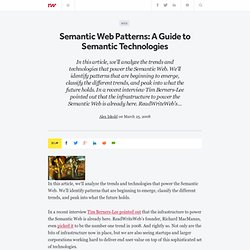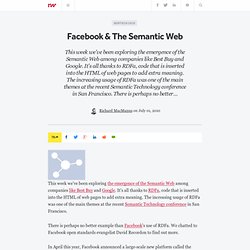

A Guide to Semantic Technologies. In this article, we'll analyze the trends and technologies that power the Semantic Web.

We'll identify patterns that are beginning to emerge, classify the different trends, and peak into what the future holds. In a recent interview Tim Berners-Lee pointed out that the infrastructure to power the Semantic Web is already here. ReadWriteWeb's founder, Richard MacManus, even picked it to be the number one trend in 2008. And rightly so. Not only are the bits of infrastructure now in place, but we are also seeing startups and larger corporations working hard to deliver end user value on top of this sophisticated set of technologies.
The Semantic Web means many things to different people, because there are a lot of pieces to it. The disagreement is not accidental, because the technology and concepts are broad. 1. We have written a lot about the different approaches to the Semantic Web - the classic bottom-up approach and the new top-down one. 2. 3. 4. 5. 6. 7. Conclusion. Facebook Open Graph: The Definitive Guide For Publishers, Users and Competitors. Facebook just shook the tech world by announcing several major initiatives that collectively constitute an aggressive move to weave the social net on top of the existing Web.The rumors were that the leading social network would launch a "Like" button for the entire Web.

Instead, Zuckerberg & Co. unveiled a bold and visionary new platform that cannot be ignored. The bits of this platform bring together the visions of a social, personalized and semantic Web that have been discussed since del.icio.us pioneered Web 2.0 back in 2004. Facebook's vision is both minimalistic and encompassing - but its ambition is to kill off its competition and use 500 million users to take over entire Web. Whether we like it (pun intended) or not, we have to understand what this move means. It impacts users, publishers, competitors and, of course, Facebook itself. Facebook Open Graph: Publisher Plugins The Open Graph is a set combination of publisher plugins, semantic markup and a developer API. Checkmate? Facebook & The Semantic Web. This week we've been exploring the emergence of the Semantic Web among companies like Best Buy and Google.

It's all thanks to RDFa, code that is inserted into the HTML of web pages to add extra meaning. The increasing usage of RDFa was one of the main themes at the recent Semantic Technology conference in San Francisco. There is perhaps no better example than Facebook's use of RDFa. We chatted to Facebook open standards evangelist David Recordon to find out more. In April this year, Facebook announced a large-scale new platform called the Open Graph. The Open Graph in a Nutshell The Open Graph is a wide-ranging platform which includes features such as 'Like' buttons and publisher plug-ins. When the Open Graph was announced, ReadWriteWeb feature writer Alex Iskold wrote a comprehensive guide to the Open Graph for publishers, users and competitors. "...the markup enables publishers to say what object is on the page - a movie, a book, a recording artist, an event, a sports team, etc. The Story of Topic Maps with Michel Biezunski. The Semantic Web of Data Tim Berners-Lee.